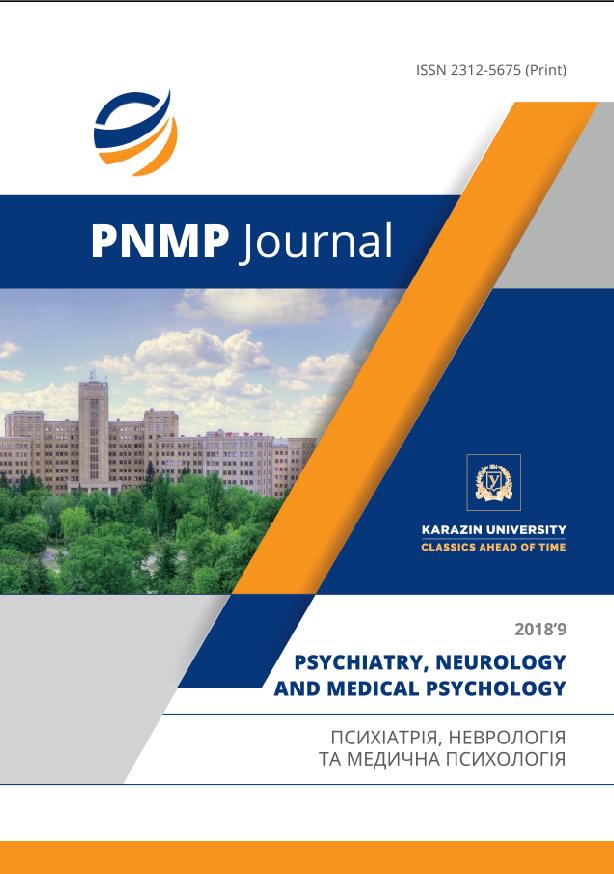CLINICAL AND ANAMNEST FEATURES OF PATIENTS WITH SERIOUS DISEASES WITH DIFFERENT TYPES OF IOPOCHONDRIC SYMPTOMATICS.
Abstract
In order to establish a link between clinical and anamnestic factors and types of hypochondriacal disorders in patients with cardiac pathology who had cardiovascular accidents, 100 patients of the cardiology department were examined. The nosological qualification of the examined patients was based on the presence of cardiovascular pathology (hypertension, coronary heart disease, atherosclerosis) with “vascular catastrophes” (myocardial infarction, pulmonary thromboembolism) and manifestations of hypochondria symptomatology. When carrying out the work, the following research methods were used: - clinical and anamnestic (for studying the history of life and illness, for the reconstruction and analysis of the psychopathogenesis of hypochondriacal symptomatology); - clinical and psychopathological (for identification of psychopathological characteristics of hypochondria symptoms at the clinical level and for analyzing the characteristics of the course of psychopathological disorders); - psychodiagnostic (to establish the levels and structure of the manifestations of hypochondria symptoms in the study cohort, as well as to determine the pathopersonological characteristics of patients, the characteristics of the internal picture of the disease, the spectrum of reactions to psychogenic factors in the structure of the disease). The study participants were examined using the original questionnaire, which, according to the registered manifestations, allowed us to determine 2 principal types of hypochondria - primary and secondary. According to the results of the study, it was found that among patients with primary hypochondria there is a significantly greater experience of visual observation of acute cardiogenic conditions or their consequences; It also notes a high frequency of diagnostics of cardiovascular diseases in direct connection with cardiogenic catastrophes. At the same time, patients with secondary hypochondria often have a rich life experience with diagnosed cardiovascular pathology and a high incidence of pressure from family members who have hypochondriacal ideas (initiate examination of the patient and limit his physical activity).
Downloads
References
Гарганеева Н. П. Основные симптомокомплексы и условия формирования невротических и аффективных расстройств у больных с сердечно-сосудистыми заболеваниями / Н. П. Гарганеева, М. Ф. Белокрылова // Сибирский мед. журн. – 2009. – № 24 (4–2). – С. 11–17.
Caffo L. Hypochondria, or, the awareness of death that goes against the cure. Commentary / L. Caffo // Ann Ist Super Sanita. – 2016. – № 52 (1). – P. 4–5.
Hanly C. Narcissism, hypochondria and the problem of alternative theories / C. Hanly // International J. of Psychoanalysis. – 2011. – № 92 (3). – P. 593–608.
Ипохондрические состояния и соматоформные расстройства / В. Г. Косенко, Г. Т. Красильников, Н. А. Косенко [и др.] // Психическое здоровье. – 2013. – № 11. – С. 44–50.
Stathopoulos G. Hypochondria: a review of its place in psychoanalytic theory / G. Stathopoulos // Psychoanalytic Quarterly. – 2017. – № 86 (2). – P. 359–381.
Медведев В. Э. Профилактика и терапия психопатологических расстройств у пациентов с сердечно-сосудистыми заболеваниями / В. Э. Медведев // Неврология, нейропсихиатрия, психосоматика. – 2012. – № (3). – С. 54–59.
Николаев Е. Л. Особенности психической дезадаптации при сердечно-сосудистых заболеваниях / Е. Л. Николаев, Е. Ю. Лазарева // Вестн. Чувашского университета. – 2013. – № 4. – С. 209–212.
Березанцев А. Ю. Соматопсихические и психосоматические расстройства: вопросы систематики и синдромологии (часть 2) / А. Ю. Березанцев // Рос. психиатрический журн. – 2011. – № 4. – С. 10–15.
Иванец Н. Н. Ипохондрическая симптоматика поздних депрессий: связь содержания ипохондрии с соматическим состоянием больных / Н. Н. Иванец, Т. И. Авдеева, М. А. Кинкулькина // Журн. неврологии и психиатрии им. С. С. Корсакова. – 2013. – № 8. – С. 10–18.
Nissen B. Hypochondria as an actual neurosis / B. Nissen // International J. of Psychoanalysis. – 2018. – Vol. 99, № 1. – P. 103–124.




